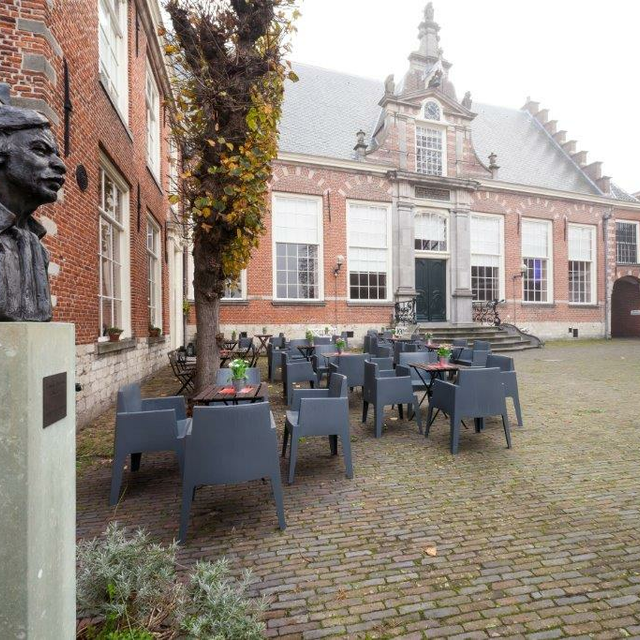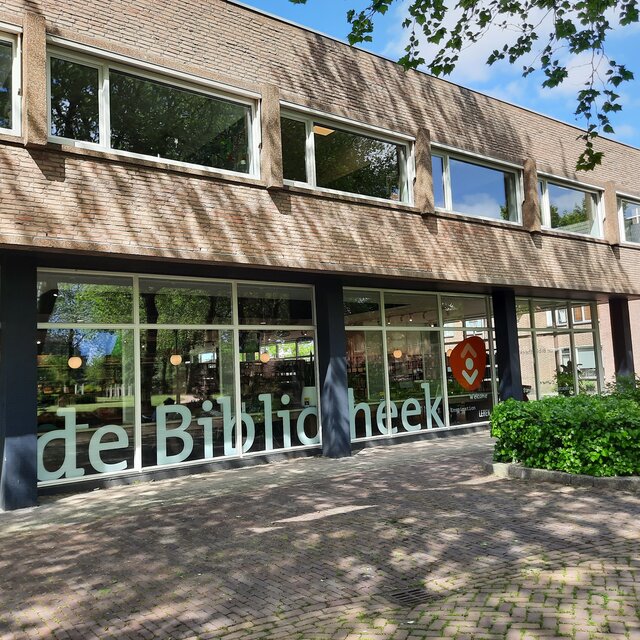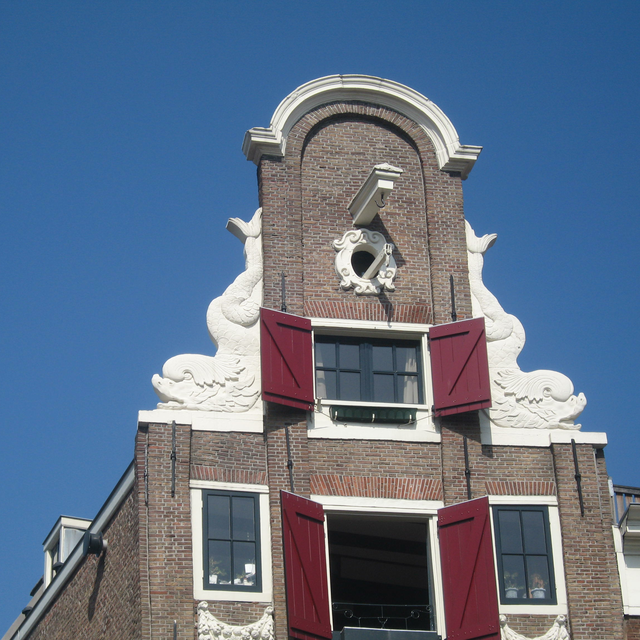Choose your municipality
There are several municipalities connected with The Green Menu, check whether your municipality is participating or choose for the national page.
Choose you menu card
There are several different menu cards. Choose a buildingtype down below and instantly start with the sustainable options!

Are cracks closed and do you have thick curtains hanging in front of the windows, but is it still very cold at the windows? Then insulating the window itself might be a possibility. Whether this is possible with your bibliotheek depends on the historical value of the frame and window, but also on the structural condition of the window. Here, too, ventilation is important to prevent moisture problems. Expert advice is very important for this.

Rob: “In het geval van onze Bibliotheek hebben we een aantal grote ingrepen kunnen doorvoeren. Zo is het pand onder ander voorzien van HR++ beglazing en vacuümglas, wat ons qua comfort en vermindering van het energieverbruik veel oplevert."

Aafke: "Het glas is op de gehele benedenverdieping vervangen door HR++ glas.Deze verdieping heeft een hele glazen wand van boven tot beneden, dus dit maakt een groot verschil op zowel de energierekening als voor het comfort."
Existing windows can be insulated by installing a secondary window on the inside of the building. With a secondary window - a second window behind the original window (inside) – you keep the existing historical window and do not change the facade view from the outside. Installing a secondary window is a job for a professional company. After installation make sure that there is sufficient ventilation to prevent condensation between the windows. When selecting the window, make sure that it matches the existing window in terms of colour, thickness of the glass and decomposition. If necessary, discuss this with a monument advisor from your municipality.
There are also single-glazing secondary windows with a heat-reflective coating, which hardly increases the investment costs, but provides 20% more energy savings on average!
Existing windows can be insulated by installing a secondary window on the inside of the building. With a secondary window - a second window behind the original window (inside) – you keep the existing historical window and do not change the facade view from the outside. Installing a secondary window is a job for a professional company. After installation make sure that there is sufficient ventilation to prevent condensation between the windows. When selecting the window, make sure that it matches the existing window in terms of colour, thickness of the glass and decomposition. If necessary, discuss this with a monument advisor from your municipality.

An insulation window is an extra insulating window that is placed on the outside of the existing window. Draughts coming through gaps in the window frame can be removed by placing the insulation window on the entire window frame. This is a major improvement over single glazing. With insulation windows, cold at the window and noise from the outside are reduced. In many cases, this is only possible if the windows are not visible from the public space.
An insulation window is an extra insulating window that is placed on the outside of the existing window. Draughts coming through gaps in the window frame can be removed by placing the insulation window on the entire window frame. This is a major improvement over single glazing. With insulation windows, cold at the window and noise from the outside are reduced. In many cases, this is only possible if the windows are not visible from the public space.

Does your single glazing have no historical value? If your glass does not have those characteristic bulges and is not stained glass, consider replacing single glazing with double glazing. Thin double glazing offers a solution for windows with a narrow rebate. This type of double glazing consists of two panes of glass with a narrow cavity between them. The cavity is filled with a gas that has an insulating effect, so you can tackle cold draughts and save significantly on your energy bill. The glass is available in different thicknesses, starting at 7 mm, and in many cases only requires a small adjustment in the window. The special insulating glass can be made with the appearance of old glass. If the current glass is historical or if the rebate in the window needs to be changed, apply for a permit.
Does your single glazing have no historical value? If your glass does not have those characteristic bulges and is not stained glass, consider replacing single glazing with double glazing. Thin double glazing offers a solution for windows with a narrow rebate. This type of double glazing consists of two panes of glass with a narrow cavity between them. The cavity is filled with a gas that has an insulating effect, so you can tackle cold draughts and save significantly on your energy bill. The glass is available in different thicknesses, starting at 7 mm, and in many cases only requires a small adjustment in the window. The special insulating glass can be made with the appearance of old glass. If the current glass is historical or if the rebate in the window needs to be changed, apply for a permit.
Vacuum glass consists of two panes of glass with a narrow cavity between them which is vacuum drawn. The space between the panes of glass is preserved by small black spheres between the panes. The insulation value of this type of glass is very good, even better than insulated glass.
Due to its low thickness, vacuum glass often fits into existing window frames without major modifications. The weight does increase, which means that hinges or counterweights may no longer work properly in the case of sliding windows. In that case, adjust the hinges. We recommend combining vacuum glass with gap sealing. By insulating windows, the natural ventilation of your building disappears, so make sure you are properly advised about possible ventilation solutions.
Vacuum glass consists of two panes of glass with a narrow cavity between them which is vacuum drawn. The space between the panes of glass is preserved by small black spheres between the panes. The insulation value of this type of glass is very good, even better than insulated glass.
Due to its low thickness, vacuum glass often fits into existing window frames without major modifications. The weight does increase, which means that hinges or counterweights may no longer work properly in the case of sliding windows. In that case, adjust the hinges. We recommend combining vacuum glass with gap sealing. By insulating windows, the natural ventilation of your building disappears, so make sure you are properly advised about possible ventilation solutions.

Double insulated glass has a good insulation value. It consists of two panes of glass with a space between them filled with a noble gas that insulates. An insulating film is also applied to the glass. By replacing your existing glass with double insulated glass, you save a lot on your energy bill and take care of cold downdraught at the windows. In addition to an insulating effect, it also reduces noise pollution from outside. Double insulated glass is not always possible in historical buildings due to its thickness and weight.
There is also triple insulated glazing, which has an even higher insulation value than double insulated glass. This is more expensive compared to double insulated glazing, the higher costs are not always recouped. Triple glazing can hardly ever be used in monumental buildings.
Insulating glass (especially double insulated glazing) can lead to the formation of condensation on uninsulated exterior walls. Proper ventilation and additional insulation measures of the building prevent this. Please consult with Monumentenzorg in advance.
Double insulated glass has a good insulation value. It consists of two panes of glass with a space between them filled with a noble gas that insulates. An insulating film is also applied to the glass. By replacing your existing glass with double insulated glass, you save a lot on your energy bill and take care of cold downdraught at the windows. In addition to an insulating effect, it also reduces noise pollution from outside. Double insulated glass is not always possible in historical buildings due to its thickness and weight.
A stained glass window is a special element in a historical building, but it is also a spot for major heat loss. There are various options for insulating stained glass windows. For example, you can place inside or outside secondary windows, this does not affect the stained glass. But there are two more options. In a museum setup, which is often used in churches, the stained glass window is removed from the frame, then insulating glazing is placed in the frame. The stained glass windows are placed on the inside in front of the glazing between lead strips. The last option is to place the stained glass window between two panes of glass.
For all options, the space between the new glazing and the stained glass must be well ventilated. After insulating your stained glass windows, you will notice that the cold air by your windows has disappeared.
A stained glass window is a special element in a historical building, but it is also a spot for major heat loss. There are various options for insulating stained glass windows. For example, you can place inside or outside secondary windows, this does not affect the stained glass. But there are two more options. In a museum setup, which is often used in churches, the stained glass window is removed from the frame, then insulating glazing is placed in the frame. The stained glass windows are placed on the inside in front of the glazing between lead strips. The last option is to place the stained glass window between two panes of glass.
For all options, the space between the new glazing and the stained glass must be well ventilated. After insulating your stained glass windows, you will notice that the cold air by your windows has disappeared.

Solar shades for your windows provides a comfortable indoor climate in the summer by keeping radiant heat from the sun outside. Solar shades on the outside keeps the heat out better in the summer than solar shades on the inside, so you don't have to cool as much, which saves energy. If solar shades on the outside is not allowed in your situation, take a look at the options for solar blinds on the inside. There are all sorts of solar blind systems on the market that differ in shape, size and colour. You can operate theblinds manually, or automatically using sensors.
Solar shades for your windows provides a comfortable indoor climate in the summer by keeping radiant heat from the sun outside. Solar shades on the outside keeps the heat out better in the summer than solar shades on the inside, so you don't have to cool as much, which saves energy. If solar shades on the outside is not allowed in your situation, take a look at the options for solar blinds on the inside. There are all sorts of solar blind systems on the market that differ in shape, size and colour. You can operate theblinds manually, or automatically using sensors.

If a skylight with single glazing has been placed in your historical roof in the past, this is probably a major heat leak. Fortunately, there are now also insulated skylights with a historical appearance. Adding skylights in historical buildings is not always allowed, so always consult the municipality before installing the skylights.

In cold periods it is possible to counteract draughts at the windows by placing thick curtains. Thick curtains have a strong insulating effect and therefore limit heat losses through the window. Do make sure that the curtains only hang in front of the windows and not over the radiators underneath; otherwise, the heat cannot reach the room properly.
Pleated blinds have a honeycomb structure and can be provided with an insulating film on the window side. These blinds are adjustable from below and above. Pleated blinds counteract draughts in cold periods due to the insulating effect and can serve as sun blinds in warm periods.

Even in earlier times, the shutters were closed on cold or hot days to keep the indoor climate comfortable. In some historical buildings, these shutters are still present, but it is often seen as a big job to close them. Still, this can save a lot of energy.

Downdraught is a cold air flow created by a cold surface at a reasonable height that ‘falls down’, as it were. This creates an uncomfortable draught flow. The solution is good window insulation with a high insulation value. You also prevent condensation on the window at a low outside temperature.